Bioinspired Algorithms for Multiple Sequence Alignment: A Systematic Review and Roadmap
Abstract
1. Introduction
- Conducting a novel SLR that identifies and summarizes bioinspired-based techniques popularly applied for solving the Multiple Sequence Alignment problem.
- Recognize and succinctly outline the benchmark datasets employed in evaluating Multiple Sequence Alignment within the framework of bioinspired algorithms.
- Identify and succinctly summarize the performance evaluation measures utilized for Multiple Sequence Alignment in the context of bioinspired algorithms.
- Explore and analyze the research challenges, open issues, and future directions for Multiple Sequence Alignment within the context of bioinspired algorithms.
2. Multiple Sequence Alignment
2.1. Classical Method
2.2. Progressive Method
2.3. Iterative Method
2.4. Evolutionary Method
3. Related Work
4. Methods
4.1. Review Planning
4.2. Conducting the Review
4.3. Research Questions
4.4. Search Strategy
- String-A: “multiple sequence alignment” AND “bioinspired”
- String-B: “multiple sequence alignment” AND “genetic algorithm”
- String-C: “multiple sequence alignment” AND “particle swarm optimization”
- String-D: “multiple sequence alignment” AND “simulated annealing”
- String-E: “multiple sequence alignment” AND “bacterial foraging”
- String-F: “multiple sequence alignment” AND “artificial bee colony”
4.5. Study Selection Criteria
4.6. Data Extraction and Synthesis
5. Search Results and Metanalysis
5.1. Description of the Identified Articles
5.2. Synthesis Results
5.2.1. RQ1: What Are the Common Bioinspired Algorithms Used for MSA?
Genetic Algorithm (GA)
Particle Swarm Optimization (PSO)
Memetic Metaheuristic (MA)
Bacterial Foraging Optimization (BFOA)
Other Bioinspired Techniques
5.2.2. RQ2: Benchmark Methods Used in MSA
- HOMSTRAD [64]: This database contains protein domains grouped according to structural and sequence similarities. Several authors have used HOMSTRAD as a benchmark database, even though it was not intended to be one. The database offers combined information on protein structure and sequence that has been taken from the PDB [95] as well as other databases, such as Pfam [96] and SCOP [97]; the most recent version of the database includes 9602 single-member families and 1032 domain families, with each family containing 2 to 41 sequences.
- BAliBASE [106,107]: This is the first extensive benchmark created especially for the alignment of multiple sequences. To guarantee the proper alignment of conserved residues, the alignment test cases are based on 3D structural superpositions that are manually improved. A wide range of issues encountered by multiple alignment methods is represented by the 217 alignments in the current version of BAliBASE, ranging from 4 to 142 sequences. These alignments are arranged into six reference sets, which include sequences with large NC-terminal extensions or internal insertions, transmembrane regions, repeated or inverted domains, and eukaryotic linear motifs.
- OXBench [105]: This offers several automatically constructed protein alignments based on aligning techniques for sequence and structure. Three data sets comprise the benchmark; between two and twenty-two sequences per alignment, the master collection now consists of 673 alignments of protein domains with known three-dimensional structures. Sequences with an unknown structure are added to the master set to create the extended dataset. Lastly, the full-length sequences for the domains in the master data set are included in the full-length data collection.
- PREFAB [90]: This dataset has 1932 multiple alignments and was built with a fully automated protocol. Two approaches of 3D structure superposition were used to identify and align pairs of sequences with known 3D structures. Next, for every pair of structures, multiple alignments were created using 50 homologous sequences found through sequence database searches; since the building is automatic, many tests can be incorporated. This benchmark’s drawback is that it only infers multiple alignment accuracy from aligning the first two sequences with known 3D structures.
- SABmark [94]: This includes reference sequence sets obtained from the SCOP protein structure categorization, separated into two groups: superfamilies and the twilight zone (Blast E-value 1) (residue identity 50 percent); each reference set’s sequence pairs are aligned using the consensus of two distinct 3D structure superposition programs. Once more, the benchmark offers pairings of sequences in only “gold standard” alignments. Even though the sequences are arranged into families, each containing a maximum of 25 sequences, a consistent multiple-alignment solution is not offered.
5.2.3. RQ3: Performance Evaluation Measures for MSA
Structural-Based Method
Simulation-Based Method
Consistency-Based Method
5.2.4. RQ4: What Are the Challenges and Open Issues in Bioinspired-Based MSA?
- The creation of more potent algorithms based on parallel and distributed paradigms and the blending of various algorithms.
- The creation of more resilient algorithms that consider the uncertainty or stochasticity present in bioinformatics (caused by errors in the technology used to collect data or by the characteristics of the data itself).
- The development of frameworks for parameter fine-tuning to take advantage of instance-specific aspects to improve results.
- The application of multi-objective techniques to take into account the various objectives in the majority of issues.
6. Limitations of the Study
- Only journal and conference papers that address bioinspired-based methods for solving the MSA problem are included in this SLR. We used our search approach in the study to find and exclude several irrelevant research publications. This ensures that the selected research papers fulfilled the investigation’s needs. However, it is believed that this review would have been improved by including other sources, such as books.
- We limited the scope of our search to English-language materials. The possibility that comparable papers in this field of study exist in languages other than English can lead to linguistic bias. Appreciatively, all of the research papers were written in English. Therefore, we do not have language bias.
- The primary databases were considered while searching through the study articles; nevertheless, other digital libraries containing relevant studies were likely overlooked. To overcome this limitation, we matched the search terms and keywords to a reputable library of research works. However, when looking for the keywords, certain synonyms could be missed. To solve this issue, the SLR methodology has been adjusted to guarantee that no crucial phrases are overlooked.
7. Conclusions and Discussion
Supplementary Materials
Author Contributions
Funding
Institutional Review Board Statement
Informed Consent Statement
Data Availability Statement
Acknowledgments
Conflicts of Interest
References
- Maiolo, L.; Bruno, S.A.; Lucarini, I.; Pecora, A.; De Iacovo, A.; Colace, L. Chemo-Resistive Gas Sensors Based on PbS Colloidal Quantum Dots. In Proceedings of the 2018 IEEE SENSORS, New Delhi, India, 28–31 October 2018; pp. 1–4. [Google Scholar]
- Metsky, H.C.; Matranga, C.B.; Wohl, S.; Schaffner, S.F.; Freije, C.A.; Winnicki, S.M.; Sabeti, P.C. Zika virus evolution and spread in the Americas. Nature 2017, 546, 411–415. [Google Scholar] [CrossRef] [PubMed]
- Zhou, Y.; Wang, Y.; Wang, K.; Kang, L.; Peng, F.; Wang, L.; Pang, J. Hybrid genetic algorithm method for efficient and robust evaluation of remaining useful life of supercapacitors. Appl. Energy 2020, 260, 114169. [Google Scholar] [CrossRef]
- Eddy, S.R. A memory-efficient dynamic programming algorithm for optimal alignment of a sequence to an RNA secondary structure. BMC Bioinform. 2002, 3, 18. [Google Scholar] [CrossRef] [PubMed]
- Jakšić, Z.; Devi, S.; Jakšić, O.; Guha, K. A comprehensive review of bio-inspired optimization algorithms including applications in microelectronics and nanophotonics. Biomimetics 2023, 8, 278. [Google Scholar] [CrossRef] [PubMed]
- Chatzou, M.; Magis, C.; Chang, J.M.; Kemena, C.; Bussotti, G.; Erb, I.; Notredame, C. Multiple sequence alignment modeling: Methods and applications. Brief. Bioinform. 2016, 17, 1009–1023. [Google Scholar] [CrossRef] [PubMed]
- Amorim, A.R.; Zafalon GF, D.; de Godoi Contessoto, A.; Valêncio, C.R.; Sato, L.M. Metaheuristics for multiple sequence alignment: A systematic review. Comput. Biol. Chem. 2021, 94, 107563. [Google Scholar] [CrossRef] [PubMed]
- Zambrano-Vega, C.; Nebro, A.J.; García-Nieto, J.; Aldana-Montes, J.F. Comparing multi-objective metaheuristics for solving a three-objective formulation of multiple sequence alignment. Prog. Artif. Intell. 2017, 6, 195–210. [Google Scholar] [CrossRef]
- Calvet, L.; Benito, S.; Juan, A.A.; Prados, F. On the role of metaheuristic optimization in bioinformatics. Int. Trans. Oper. Res. 2023, 30, 2909–2944. [Google Scholar] [CrossRef]
- Chaabane, L.; Khelassi, A.; Terziev, A.; Andreopoulos, N.; Jesus, M.D.; Estrela, V.V. Particle Swarm Optimization with Tabu Search Algorithm (PSO-TS) Applied to Multiple Sequence Alignment Problem. In Advances in Multidisciplinary Medical Technologies—Engineering, Modeling and Findings: Proceedings of the ICHSMT 2019; Springer International Publishing: Berlin/Heidelberg, Germany, 2021; pp. 103–114. [Google Scholar]
- Paruchuri, T.; Kancharla, G.R.; Dara, S. Solving multiple sequence alignment problems by using a swarm intelligent optimization based approach. Int. J. Electr. Comput. Eng. 2023, 13, 1097. [Google Scholar] [CrossRef]
- Mishra, A.; Tripathi, B.K.; Soam, S.S. A genetic algorithm based approach for the optimization of multiple sequence alignment. In Proceedings of the 2020 International Conference on Computational Performance Evaluation (ComPE), Shillong, India, 2–4 July 2020; pp. 415–418. [Google Scholar]
- Dabba, A.; Tari, A.; Zouache, D. Multiobjective artificial fish swarm algorithm for multiple sequence alignment. INFOR Inf. Syst. Oper. Res. 2020, 58, 38–59. [Google Scholar] [CrossRef]
- Yu, Y.; Zhang, C.; Ye, L.; Yang, M.; Zhang, C. A Multi-objective Artificial Bee Colony Algorithm for Multiple Sequence Alignment. In Proceedings of the International Conference on Simulation Tools and Techniques; Springer International Publishing: Cham, Switzerland, 2021; pp. 564–576. [Google Scholar]
- Rubio-Largo, Á.; Vega-Rodríguez, M.A.; González-Álvarez, D.L. Hybrid multi-objective artificial bee colony for multiple sequence alignment. Appl. Soft Comput. 2016, 41, 157–168. [Google Scholar] [CrossRef]
- Makigaki, S.; Ishida, T. Sequence alignment using machine learning for accurate template-based protein structure prediction. Bioinformatics 2020, 36, 104–111. [Google Scholar] [CrossRef]
- Fukuda, H. Cascade and cluster of correlated reactions as causes of stochastic defects in extreme ultraviolet lithography. J. Micro/Nanolithogr. MEMS MOEMS 2020, 19, 024601. [Google Scholar] [CrossRef]
- Bawono, P.; Dijkstra, M.; Pirovano, W.; Feenstra, A.; Abeln, S.; Heringa, J. Multiple sequence alignment. In Bioinformatics: Data, Sequence Analysis, and Evolution; Springer: Berlin/Heidelberg, Germany, 2017; Volume I, pp. 167–189. [Google Scholar]
- Yadav, S.K.; Jha, S.K.; Singh, S.; Dixit, P.; Prakash, S.; Singh, A. Optimizing Multiple Sequence Alignment using Multi-objective Genetic Algorithms. In Proceedings of the 2022 International Conference on Decision Aid Sciences and Applications (DASA) IEEE, Chiangrai, Thailand, 23–25 March 2022; pp. 113–117. [Google Scholar]
- Lalwani, S.; Kumar, R.; Gupta, N. A novel two-level particle swarm optimization approach for efficient multiple sequence alignment. Memetic Comput. 2015, 7, 119–133. [Google Scholar] [CrossRef]
- Gupta, R.; Agarwal, P.; Soni, A.K. MSA-GA: Multiple sequence alignment tool based on genetic approach. Int. J. Soft Comput. Softw. Eng. 2013, 8, 1–11. [Google Scholar]
- Zafalon GF, D.; Gomes, V.Z.; Amorim, A.R.; Valêncio, C.R. A Hybrid Approach using Progressive and Genetic Algorithms for Improvements in Multiple Sequence Alignments. ICEIS 2021, 2, 384–391. [Google Scholar]
- Wang, J.; Yu, L.; Zhang, W.; Gong, Y.; Xu, Y.; Wang, B.; Zhang, D. Irgan: A minimax game for unifying generative and discriminative information retrieval models. In Proceedings of the 40th International ACM SIGIR Conference on Research and Development in Information Retrieval, Tokyo, Japan, 7–11 August 2017; pp. 515–524. [Google Scholar]
- Ali, A.F.; Hassanien, A.E. A Survey of Metaheuristics Methods for Bioinformatics Applications. In Applications of Intelligent Optimization in Biology and Medicine: Current Trends and Open Problems; Springer International Publishing: Cham, Switzerland, 2015; pp. 23–46. [Google Scholar]
- Katoh, K.; Misawa, K.; Kuma, K.I.; Miyata, T. MAFFT: A novel method for rapid multiple sequence alignment based on fast Fourier transform. Nucleic Acids Res. 2002, 30, 3059–3066. [Google Scholar] [CrossRef]
- Iantorno, S.; Gori, K.; Goldman, N.; Gil, M.; Dessimoz, C. Who watches the watchmen? An appraisal of benchmarks for multiple sequence alignment. Mult. Seq. Alignment Methods 2014, 1079, 59–73. [Google Scholar]
- Rasmussen, T.K.; Krink, T. Improved Hidden Markov Model training for multiple sequence alignment by a particle swarm optimization—Evolutionary algorithm hybrid. Biosystems 2003, 72, 5–17. [Google Scholar] [CrossRef]
- Pei, J.; Grishin, N.V. MUMMALS: Multiple sequence alignment improved by using hidden Markov models with local structural information. Nucleic Acids Res. 2006, 34, 4364–4374. [Google Scholar] [CrossRef]
- Lee, Z.J.; Su, S.F.; Chuang, C.C.; Liu, K.H. Genetic algorithm with ant colony optimization (GA-ACO) for multiple sequence alignment. Appl. Soft Comput. 2008, 8, 55–78. [Google Scholar] [CrossRef]
- Notredame, C.; Higgins, D.G. SAGA: Sequence alignment by genetic algorithm. Nucleic Acids Res. 1996, 24, 1515–1524. [Google Scholar] [CrossRef] [PubMed]
- Paruchuri, T.; Kancharla, G.R.; Dara, S.; Yadav, R.K.; Jadav, S.S.; Dhamercherla, S.; Vidyarthi, A. Nature Inspired Algorithms for Solving Multiple Sequence Alignment Problem: A Review. Arch. Comput. Methods Eng. 2022, 29, 5237–5258. [Google Scholar] [CrossRef]
- Gautam, R.; Kaur, P.; Sharma, M. A comprehensive review on nature inspired computing algorithms for the diagnosis of chronic disorders in human beings. Prog. Artif. Intell. 2019, 8, 401–424. [Google Scholar] [CrossRef]
- Chatterjee, S.; Hasibuzzaman, M.M.; Iftiea, A.; Mukharjee, T.; Nova, S.S. A hybrid genetic algorithm with chemical reaction optimization for multiple sequence alignment. In Proceedings of the 22nd International Conference on Computer and Information Technology (ICCIT), Dhaka, Bangladesh, 18–20 December 2019; pp. 1–6. [Google Scholar]
- Fan, X.; Sayers, W.; Zhang, S.; Han, Z.; Ren, L.; Chizari, H. Review and classification of bio-inspired algorithms and their applications. J. Bionic Eng. 2020, 17, 611–631. [Google Scholar] [CrossRef]
- Rajwar, K.; Deep, K.; Das, S. An exhaustive review of the metaheuristic algorithms for search and optimization: Taxonomy, applications, and open challenges. Artif. Intell. Rev. 2023, 56, 13187–13257. [Google Scholar] [CrossRef] [PubMed]
- Chao, J.; Tang, F.; Xu, L. Developments in algorithms for sequence alignment: A review. Biomolecules 2022, 12, 546. [Google Scholar] [CrossRef]
- Katoh, K.; Rozewicki, J.; Yamada, K.D. MAFFT online service: Multiple sequence alignment, interactive sequence choice and visualization. Brief. Bioinform. 2019, 20, 1160–1166. [Google Scholar] [CrossRef]
- Katoh, K.; Kuma, K.I.; Toh, H.; Miyata, T. MAFFT version 5: Improvement in accuracy of multiple sequence alignment. Nucleic Acids Res. 2005, 33, 511–518. [Google Scholar] [CrossRef]
- Sievers, F.; Higgins, D.G. Clustal Omega for making accurate alignments of many protein sequences. Protein Sci. 2018, 27, 135–145. [Google Scholar] [CrossRef]
- Chowdhury, B.; Garai, G. A review on multiple sequence alignment from the perspective of genetic algorithm. Genomics 2017, 109, 419–431. [Google Scholar] [CrossRef] [PubMed]
- Almanza-Ruiz, S.H.; Chavoya, A.; Duran-Limon, H.A. Parallel protein multiple sequence alignment approaches: A systematic literature review. J. Supercomput. 2023, 79, 1201–1234. [Google Scholar] [CrossRef]
- Mohammadian, V.; Navimipour, N.J.; Hosseinzadeh, M.; Darwesh, A. Comprehensive and systematic study on the fault tolerance architectures in cloud computing. J. Circuits Syst. Comput. 2020, 29, 2050240. [Google Scholar] [CrossRef]
- Keele, S. Guidelines for Performing Systematic Literature Reviews in Software Engineering; EBSE Technical Report EBSE-2007-01; Software Engineering Group: Staffordshire, UK, 2007. [Google Scholar]
- Genc-Nayebi, N.; Abran, A. A systematic literature review: Opinion mining studies from mobile app store user reviews. J. Syst. Softw. 2017, 125, 207–219. [Google Scholar] [CrossRef]
- Kitchenham, B.; Brereton, O.P.; Budgen, D.; Turner, M.; Bailey, J.; Linkman, S. Systematic literature reviews in software engineering–a systematic literature review. Inf. Softw. Technol. 2009, 51, 7–15. [Google Scholar] [CrossRef]
- Ashtiani, M.N.; Raahemi, B. Intelligent fraud detection in financial statements using machine learning and data mining: A systematic literature review. IEEE Access 2021, 10, 72504–72525. [Google Scholar] [CrossRef]
- Kumar, M. An enhanced algorithm for multiple sequence alignment of protein sequences using genetic algorithm. EXCLI J. 2015, 14, 1232. [Google Scholar]
- Chentoufi, A.; El Fatmi, A.; Bekri, A.; Benhlima, S.; Sabbane, M. Genetic algorithms and dynamic weighted sum method for RNA alignment. In Proceedings of the 2017 Intelligent Systems and Computer Vision (ISCV), Fez, Morocco, 17–19 April 2017; pp. 1–5. [Google Scholar]
- Kaya, M.; Sarhan, A.; Alhajj, R. Multiple sequence alignment with affine gap by using multi-objective genetic algorithm. Comput. Methods Programs Biomed. 2014, 114, 38–49. [Google Scholar] [CrossRef]
- Amorim, A.R.; Visotaky JM, V.; de Godoi Contessoto, A.; Neves, L.A.; De Souza RC, G.; Valêncio, C.R.; Zafalon GF, D. Performance improvement of genetic algorithm for multiple sequence alignment. In Proceedings of the 2016 17th International Conference on Parallel and Distributed Computing, Applications and Technologies (PDCAT), Guangzhou, China, 16–18 December 2016; pp. 69–72. [Google Scholar]
- Naznin, F.; Sarker, R.; Essam, D. Progressive alignment method using genetic algorithm for multiple sequence alignment. IEEE Trans. Evol. Comput. 2012, 16, 615–631. [Google Scholar] [CrossRef]
- Amorim, A.R.; Zafalon GF, D.; Neves, L.A.; Pinto, A.R.; Valêncio, C.R.; Machado, J.M. Improvements in the sensibility of MSA-GA tool using COFFEE objective function. In Proceedings of the 3rd International Conference on Mathematical Modeling in Physical Sciences (IC-MSQUARE 2014), Madrid, Spain, 28–31 August 2014; IOP Publishing: Bristol, UK, 2014; Volume 574, p. 012104. [Google Scholar]
- Rani, R.R.; Ramyachitra, D. Application of genetic algorithm by influencing the crossover parameters for multiple sequence alignment. In Proceedings of the 2017 4th IEEE Uttar Pradesh Section International Conference on Electrical, Computer and Electronics 2017 (UPCON), Mathura, India, 26–28 October 2017; pp. 33–38. [Google Scholar]
- Nayeem, M.A.; Bayzid, M.S.; Rahman, A.H.; Shahriyar, R.; Rahman, M.S. Multi-objective formulation of multiple sequence alignment for phylogeny inference. IEEE Trans. Cybern. 2020, 52, 2775–2786. [Google Scholar] [CrossRef]
- Belattar, K.; Zemali, E.A.; Baouni, S.; Dehni, S. Parallel multiple DNA sequence alignment using genetic algorithm and asynchronous advantage actor critic model. Int. J. Bioinform. Res. Appl. 2022, 18, 460–478. [Google Scholar] [CrossRef]
- Sievers, F.; Barton, G.J.; Higgins, D.G. Multiple sequence alignments. Bioinformatics 2020, 227, 227–250. [Google Scholar]
- Chowdhury, B.; Garai, G. A bi-objective function optimization approach for multiple sequence alignment using genetic algorithm. Soft Comput. 2020, 24, 15871–15888. [Google Scholar] [CrossRef]
- Silva FJ, M.D.; Pérez JM, S.; Pulido JA, G.; Rodriguez, M.A.V. Parallel niche pareto AlineaGA–an evolutionary multi-objective approach on multiple sequence alignment. J. Integr. Bioinform. 2011, 8, 57–72. [Google Scholar] [CrossRef]
- Ortuno, F.M.; Valenzuela, O.; Rojas, F.; Pomares, H.; Florido, J.P.; Urquiza, J.M.; Rojas, I. Optimizing multiple sequence alignments using a genetic algorithm based on three objectives: Structural information, non-gaps percentage and totally conserved columns. Bioinformatics 2013, 29, 2112–2121. [Google Scholar] [CrossRef] [PubMed]
- Nizam, A.; Ravi, J.; Subburaya, K. Cyclic genetic algorithm for multiple sequence alignment. Int. J. Res. Rev. Electr. Comput. Eng. (IJRRECE) 2011, 1, 20. [Google Scholar]
- Naznin, F.; Sarker, R.; Essam, D. Vertical decomposition with genetic algorithm for multiple sequence alignment. BMC Bioinform. 2011, 12, 353. [Google Scholar] [CrossRef]
- Luo, J.; Zhang, L.; Liang, C. A multigroup parallel genetic algorithm for multiple sequence alignment. In Proceedings of the Artificial Intelligence and Computational Intelligence: Third International Conference, AICI 2011, Taiyuan, China, 24–25 September 2011; Proceedings, Part I 3. Springer: Berlin Heidelberg, 2011; pp. 308–316. [Google Scholar]
- Narimani, Z.; Beigy, H.; Abolhassani, H. A new genetic algorithm for multiple sequence alignment. Int. J. Comput. Intell. Appl. 2012, 11, 1250023. [Google Scholar] [CrossRef]
- Zambrano-Vega, C.; Nebro, A.J.; Durillo, J.J.; García-Nieto, J.; Aldana-Montes, J.F. Multiple sequence alignment with multi-objective metaheuristics. a comparative study. Int. J. Intell. Syst. 2017, 32, 843–861. [Google Scholar] [CrossRef]
- Kayed, M.; Elngar, A.A. NestMSA: A new multiple sequence alignment algorithm. J. Supercomput. 2020, 76, 9168–9188. [Google Scholar] [CrossRef]
- Lalwani, S.; Kumar, R.; Deep, K. Multi-objective two-level swarm intelligence approach for multiple RNA sequence-structure alignment. Swarm Evol. Comput. 2017, 34, 130–144. [Google Scholar] [CrossRef]
- Zhan, Q.; Wang, N.; Jin, S.; Tan, R.; Jiang, Q.; Wang, Y. ProbPFP: A multiple sequence alignment algorithm combining hidden Markov model optimized by particle swarm optimization with partition function. BMC Bioinform. 2019, 20, 573. [Google Scholar] [CrossRef] [PubMed]
- Rubio-Largo, Á.; Vega-Rodríguez, M.A.; González-Álvarez, D.L. A hybrid multi-objective memetic metaheuristic for multiple sequence alignment. IEEE Trans. Evol. Comput. 2015, 20, 499–514. [Google Scholar] [CrossRef]
- Ibrahim, M.K.; Yusof, U.K.; Eisa, T.A.E.; Nasser, M. Enhanced Genetic Method for Optimizing Multiple Sequence Alignment. Mathematics 2023, 11, 4578. [Google Scholar] [CrossRef]
- Reddy, G.T.; Reddy MP, K.; Lakshmanna, K.; Rajput, D.S.; Kaluri, R.; Srivastava, G. Hybrid genetic algorithm and a fuzzy logic classifier for heart disease diagnosis. Evol. Intell. 2020, 13, 185–196. [Google Scholar] [CrossRef]
- Su, Y.; Jin, S.; Zhang, X.; Shen, W.; Eden, M.R.; Ren, J. Stakeholder-oriented multi-objective process optimization based on an improved genetic algorithm. Comput. Chem. Eng. 2020, 132, 106618. [Google Scholar] [CrossRef]
- Gondro, C.; Kinghorn, B.P. A simple genetic algorithm for multiple sequence alignment. Genet. Mol. Res. 2007, 6, 964–982. [Google Scholar]
- Notredame, C.; Higgins, D.G.; Heringa, J. T-Coffee: A novel method for fast and accurate multiple sequence alignment. J. Mol. Biol. 2000, 302, 205–217. [Google Scholar] [CrossRef]
- Rani, R.R.; Ramyachitra, D. Multiple sequence alignment using multi-objective based bacterial foraging optimization algorithm. Biosystems 2016, 150, 177–189. [Google Scholar] [CrossRef]
- Thompson, J.D.; Koehl, P.; Ripp, R.; Poch, O. BAliBASE 3.0: Latest developments of the multiple sequence alignment benchmark. Proteins Struct. Funct. Bioinform. 2005, 61, 127–136. [Google Scholar] [CrossRef]
- Edgar, R.C. MUSCLE: Multiple sequence alignment with high accuracy and high throughput. Nucleic Acids Res. 2004, 32, 1792–1797. [Google Scholar] [CrossRef] [PubMed]
- Niu, W.J.; Feng, Z.K.; Chen, Y.B.; Min, Y.W.; Liu, S.; Li, B.J. Multireservoir system operation optimization by hybrid quantum-behaved particle swarm optimization and heuristic constraint handling technique. J. Hydrol. 2020, 590, 125477. [Google Scholar] [CrossRef]
- Farshi, T.R.; Drake, J.H.; Özcan, E. A multimodal particle swarm optimization-based approach for image segmentation. Expert Syst. Appl. 2020, 149, 113233. [Google Scholar] [CrossRef]
- Cui, Z.; Zhang, J.; Wu, D.; Cai, X.; Wang, H.; Zhang, W.; Chen, J. Hybrid many-objective particle swarm optimization algorithm for green coal production problem. Inf. Sci. 2020, 518, 256–271. [Google Scholar] [CrossRef]
- Rajagopal, A.; Joshi, G.P.; Ramachandran, A.; Subhalakshmi, R.T.; Khari, M.; Jha, S.; You, J. A deep learning model based on multi-objective particle swarm optimization for scene classification in unmanned aerial vehicles. IEEE Access 2020, 8, 135383–135393. [Google Scholar] [CrossRef]
- Liang, J.; Ge, S.; Qu, B.; Yu, K.; Liu, F.; Yang, H.; Li, Z. Classified perturbation mutation based particle swarm optimization algorithm for parameters extraction of photovoltaic models. Energy Convers. Manag. 2020, 203, 112138. [Google Scholar] [CrossRef]
- Du, K.L.; Swamy, M.N. Search and Optimization by Metaheuristics: Techniques and Algorithms Inspired by Nature; Birkhäuser: Basel, Switzerland, 2016; pp. 1–10. [Google Scholar]
- Wang, C.R.; Zhou, C.L.; Ma, J.W. An improved artificial fish-swarm algorithm and its application in feed-forward neural networks. In Proceedings of the 2005 International Conference on Machine Learning and Cybernetics, Guangzhou, China, 18–21 August 2005; Volume 5, pp. 2890–2894. [Google Scholar]
- Yadav, R.K.; Banka, H. IBBOMSA: An improved biogeography-based approach for multiple sequence alignment. Evol. Bioinform. 2016, 12, EBO–S40457. [Google Scholar] [CrossRef]
- Liu, Y.; Schmidt, B.; Maskell, D.L. MSAProbs: Multiple sequence alignment based on pair hidden Markov models and partition function posterior probabilities. Bioinformatics 2010, 26, 1958–1964. [Google Scholar] [CrossRef]
- Rojas, M.G.; Carballido, J.A.; Olivera, A.C.; Vidal, P.J. A Memetic Cellular Genetic Algorithm for Multiple Sequence Alignment. In Proceedings of the 2020 IEEE Congreso Bienal de Argentina 2020, (ARGENCON), Resistencia, Argentina, 1–4 December 2020; pp. 1–8. [Google Scholar]
- Garg, P. A Comparison between Memetic algorithm and Genetic algorithm for the cryptanalysis of Simplified Data Encryption Standard algorithm. arXiv 2010, arXiv:1004.0574. [Google Scholar]
- Rubio-Largo, Á.; Vega-Rodríguez, M.A.; González-Álvarez, D.L. Parallel H4MSA for multiple sequence alignment. In Proceedings of the Trustcom/BigDataSE/ISPA, Helsinki, Finland, 20–22 August 2015; Volume 3, pp. 242–247. [Google Scholar]
- Rubio-Largo, Á.; Vanneschi, L.; Castelli, M.; Vega-Rodríguez, M.A. A characteristic-based framework for multiple sequence aligners. IEEE Trans. Cybern. 2016, 48, 41–51. [Google Scholar] [CrossRef]
- Zhu, Z.; Zhou, J.; Ji, Z.; Shi, Y.H. DNA sequence compression using adaptive particle swarm optimization-based memetic algorithm. IEEE Trans. Evol. Comput. 2011, 15, 643–658. [Google Scholar] [CrossRef]
- Yao, D.; Jiang, M.; You, X.; Abulizi, A.; Hou, R. An algorithm of multiple sequence alignment based on consensus sequence searched by simulated annealing and star alignment. In Proceedings of the 2015 International Symposium on Bioelectronics and Bioinformatics (ISBB), Beijing, China, 14–17 October 2015; pp. 3–6. [Google Scholar]
- Hussein, A.M.; Abdullah, R.; AbdulRashid, N.; Ali, A.N.B. Protein multiple sequence alignment by basic flower pollination algorithm. In Proceedings of the 2017 8th International Conference on Information Technology (ICIT), Amman, Jordan, 17–18 May 2017; pp. 833–838. [Google Scholar]
- Hussein, A.M.; Abdullah, R.; AbdulRashid, N. Flower pollination algorithm with profile technique for multiple sequence alignment. In Proceedings of the 2019 IEEE Jordan International Joint Conference on Electrical Engineering and Information Technology (JEEIT), Amman, Jordan, 9–11 April 2019; pp. 571–576. [Google Scholar]
- Altwaijry, N.; Almasoud, M.; Almalki, A.; Al-Turaiki, I. Multiple sequence alignment using a multi-objective artificial bee colony algorithm. In Proceedings of the 2020 3rd International Conference on Computer Applications & Information Security (ICCAIS), Riyadh, Saudi Arabia, 19–21 May 2020; pp. 1–6. [Google Scholar]
- Ye, L. A Decomposition and Dominance-Based Multi-objective Artificial Bee Colony Algorithm for Multiple Sequence Alignment. Mob. Inf. Syst. 2022, 2022, 5444055. [Google Scholar]
- Bateman, A.; Coin, L.; Durbin, R.; Finn, R.D.; Hollich, V.; Griffiths-Jones, S.; Eddy, S.R. The Pfam protein families database. Nucleic Acids Res. 2004, 32 (Suppl. 1), D138–D141. [Google Scholar] [CrossRef] [PubMed]
- Lei, X.; Sun, J.; Xu, X.; Guo, L. Artificial bee colony algorithm for solving multiple sequence alignment. In Proceedings of the 2010 IEEE Fifth International Conference on Bio-Inspired Computing: Theories and Applications (BIC-TA), Changsha, Cina, 23–26 September 2010; pp. 337–342. [Google Scholar]
- Zemali, E.A.; Boukra, A. A new hybrid bio-inspired approach to resolve the multiple sequence alignment problem. In Proceedings of the 2016 International Conference on Control, Decision and Information Technologies (CoDIT), Saint Julian’s, Malta, 6–8 April 2016; pp. 108–113. [Google Scholar]
- Manikandan, P.; Ramyachitra, D. Bacterial foraging optimization–genetic algorithm for multiple sequence alignment with multi-objectives. Sci. Rep. 2017, 7, 8833. [Google Scholar] [CrossRef]
- Eusuff, M.; Lansey, K.; Pasha, F. Shuffled frog-leaping algorithm: A memetic meta-heuristic for discrete optimization. Eng. Optim. 2006, 38, 129–154. [Google Scholar] [CrossRef]
- Zhang, X.; Kang, Q.; Cheng, J.; Wang, X. A novel hybrid algorithm based on biogeography-based optimization and grey wolf optimizer. Appl. Soft Comput. 2018, 67, 197–214. [Google Scholar] [CrossRef]
- Talbi, H.; Draa, A. A new real-coded quantum-inspired evolutionary algorithm for continuous optimization. Appl. Soft Comput. 2017, 61, 765–791. [Google Scholar] [CrossRef]
- Mahdad, B.; Srairi, K. Security constrained optimal power flow solution using new adaptive partitioning flower pollination algorithm. Appl. Soft Comput. 2016, 46, 501–522. [Google Scholar] [CrossRef]
- Lassmann, T. Kalign 3: Multiple sequence alignment of large datasets. Bioinformatics 2020, 36, 1928–1929. [Google Scholar] [CrossRef]
- Li, C.; Zhan, G.; Li, Z. News text classification based on improved Bi-LSTM-CNN. In Proceedings of the 9th International Conference on Information Technology in Medicine and Education (ITME), Hangzhou, China, 19–21 October 2018; pp. 890–893. [Google Scholar]
- Gardner, P.P.; Wilm, A.; Washietl, S. A benchmark of multiple sequence alignment programs upon structural RNAs. Nucleic Acids Res. 2005, 33, 2433–2439. [Google Scholar] [CrossRef]
- Cartwright, R.A. DNA assembly with gaps (Dawg): Simulating sequence evolution. Bioinformatics 2005, 21 (Suppl. S3), iii31–iii38. [Google Scholar] [CrossRef] [PubMed][Green Version]
- Hall, B.G. Simulating DNA coding sequence evolution with EvolveAGene 3. Mol. Biol. Evol. 2008, 25, 688–695. [Google Scholar] [CrossRef] [PubMed]
- Fletcher, W.; Yang, Z. INDELible: A flexible simulator of biological sequence evolution. Mol. Biol. Evol. 2009, 26, 1879–1888. [Google Scholar] [CrossRef] [PubMed]
- Sipos, B.; Massingham, T.; Jordan, G.E.; Goldman, N. PhyloSim-Monte Carlo simulation of sequence evolution in the R statistical computing environment. BMC Bioinform. 2011, 12, 104. [Google Scholar] [CrossRef] [PubMed]
- Koestler, T.; Haeseler, A.V.; Ebersberger, I. REvolver: Modeling sequence evolution under domain constraints. Mol. Biol. Evol. 2012, 29, 2133–2145. [Google Scholar] [CrossRef] [PubMed]
- Dalquen, D.A.; Anisimova, M.; Gonnet, G.H.; Dessimoz, C. ALF—A simulation framework for genome evolution. Mol. Biol. Evol. 2012, 29, 1115–1123. [Google Scholar] [CrossRef] [PubMed]
- Lassmann, T.; Sonnhammer, E.L. Automatic assessment of alignment quality. Nucleic Acids Res. 2005, 33, 7120–7128. [Google Scholar] [CrossRef] [PubMed]
- Landan, G.; Graur, D. Heads or tails: A simple reliability check for multiple sequence alignments. Mol. Biol. Evol. 2007, 24, 1380–1383. [Google Scholar] [CrossRef]
- Do, C.B.; Mahabhashyam, M.S.; Brudno, M.; Batzoglou, S. ProbCons: Probabilistic consistency-based multiple sequence alignment. Genome Res. 2005, 15, 330–340. [Google Scholar] [CrossRef]
- Thompson, J.D.; Plewniak, F.; Poch, O. A comprehensive comparison of multiple sequence alignment programs. Nucleic Acids Res. 1999, 27, 2682–2690. [Google Scholar] [CrossRef]
- Demšar, J. Statistical comparisons of classifiers over multiple data sets. J. Mach. Learn. Res. 2006, 7, 1–30. [Google Scholar]
- Roshan, U.; Livesay, D.R. Probalign: Multiple sequence alignment using partition function posterior probabilities. Bioinformatics 2006, 22, 2715–2721. [Google Scholar] [CrossRef]
- Kemena, C.; Taly, J.F.; Kleinjung, J.; Notredame, C. STRIKE: Evaluation of protein MSAs using a single 3D structure. Bioinformatics 2011, 27, 3385–3391. [Google Scholar] [CrossRef] [PubMed]
- Dessimoz, C.; Gil, M. Phylogenetic assessment of alignments reveals neglected tree signal in gaps. Genome Biol. 2010, 11, R37. [Google Scholar] [CrossRef] [PubMed]
- Blackburne, B.P.; Whelan, S. Measuring the distance between multiple sequence alignments. Bioinformatics 2012, 28, 495–502. [Google Scholar] [CrossRef] [PubMed]
- Lassmann, T.; Frings, O.; Sonnhammer, E.L. Kalign2: High-performance multiple alignment of protein and nucleotide sequences allowing external features. Nucleic Acids Res. 2009, 37, 858–865. [Google Scholar] [CrossRef] [PubMed]
- Bayliss, C.; Juan, A.A.; Currie, C.S.; Panadero, J. A learnheuristic approach for the team orienteering problem with aerial drone motion constraints. Appl. Soft Comput. 2020, 92, 106280. [Google Scholar] [CrossRef]
- Chica, M.; Juan Pérez, A.A.; Cordon, O.; Kelton, D. Why Simheuristics? Benefits, Limitations, and Best Practices when Combining Metaheuristics with Simulation. Benefits, Limitations, and Best Practices when Combining Metaheuristics with Simulation. 2017. Available online: https://papers.ssrn.com/sol3/papers.cfm?abstract_id=2919208 (accessed on 1 January 2024).
- Talbi, E.G. (Ed.) Hybrid Metaheuristics; Springer: Berlin/Heidelberg, Germany, 2013; Volume 166. [Google Scholar]
- Hughes, J.; Houghten, S.; Mallén-Fullerton, G.M.; Ashlock, D. Recentering and restarting genetic algorithm variations for DNA fragment assembly. In Proceedings of the 2014 IEEE Conference on Computational Intelligence in Bioinformatics and Computational Biology, Honolulu, HI, USA, 21–24 May 2014; pp. 1–8. [Google Scholar]
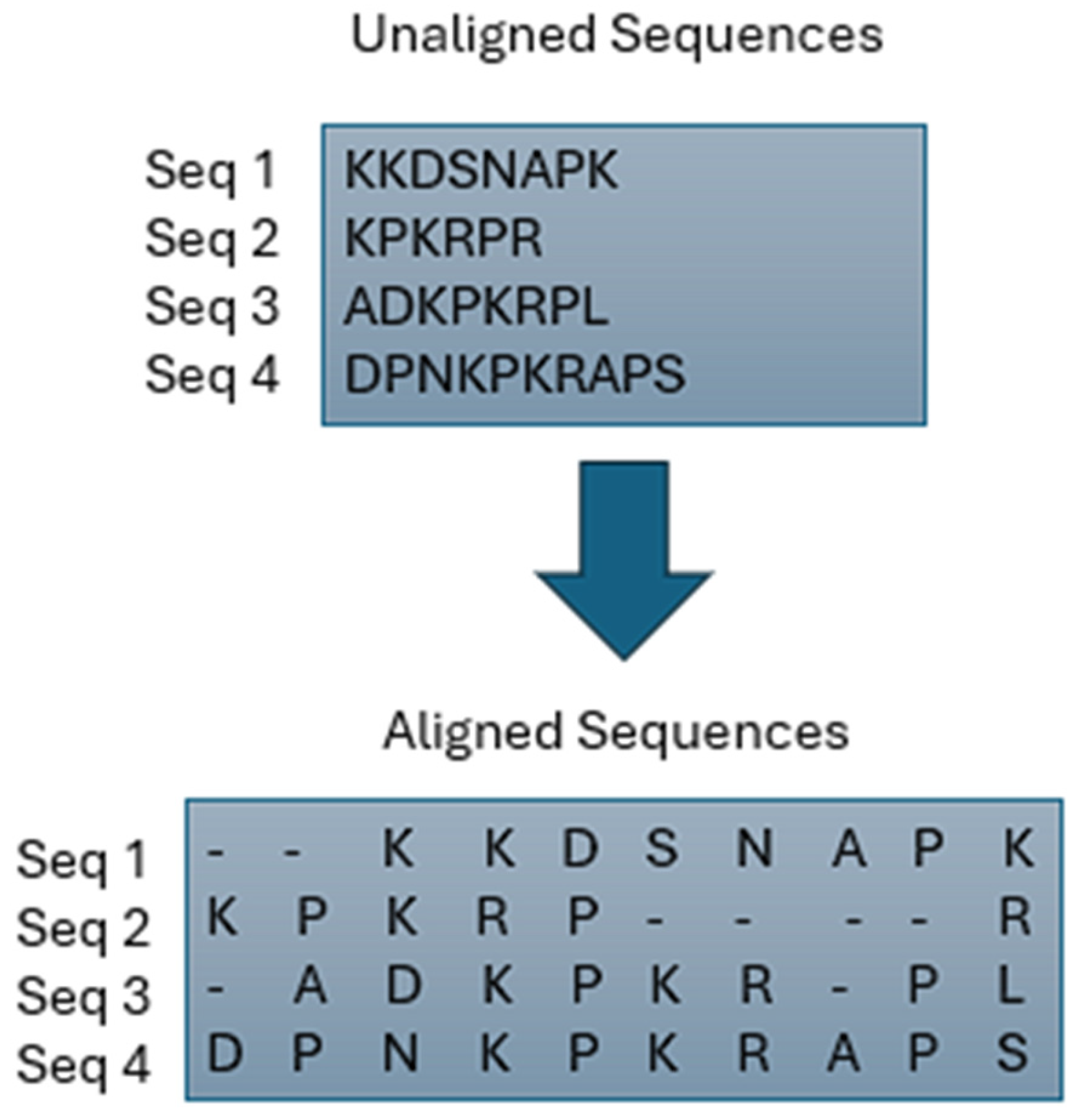


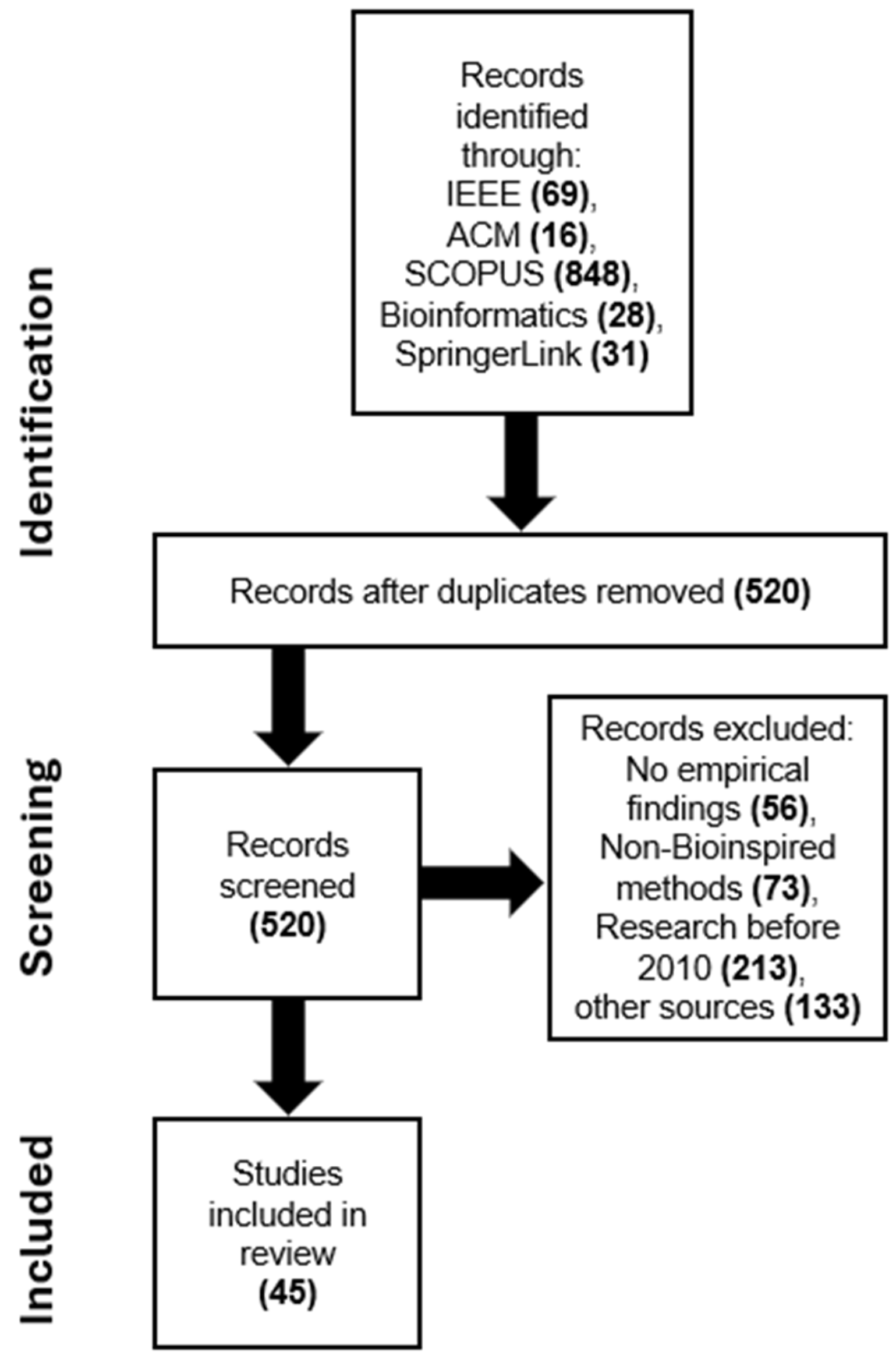

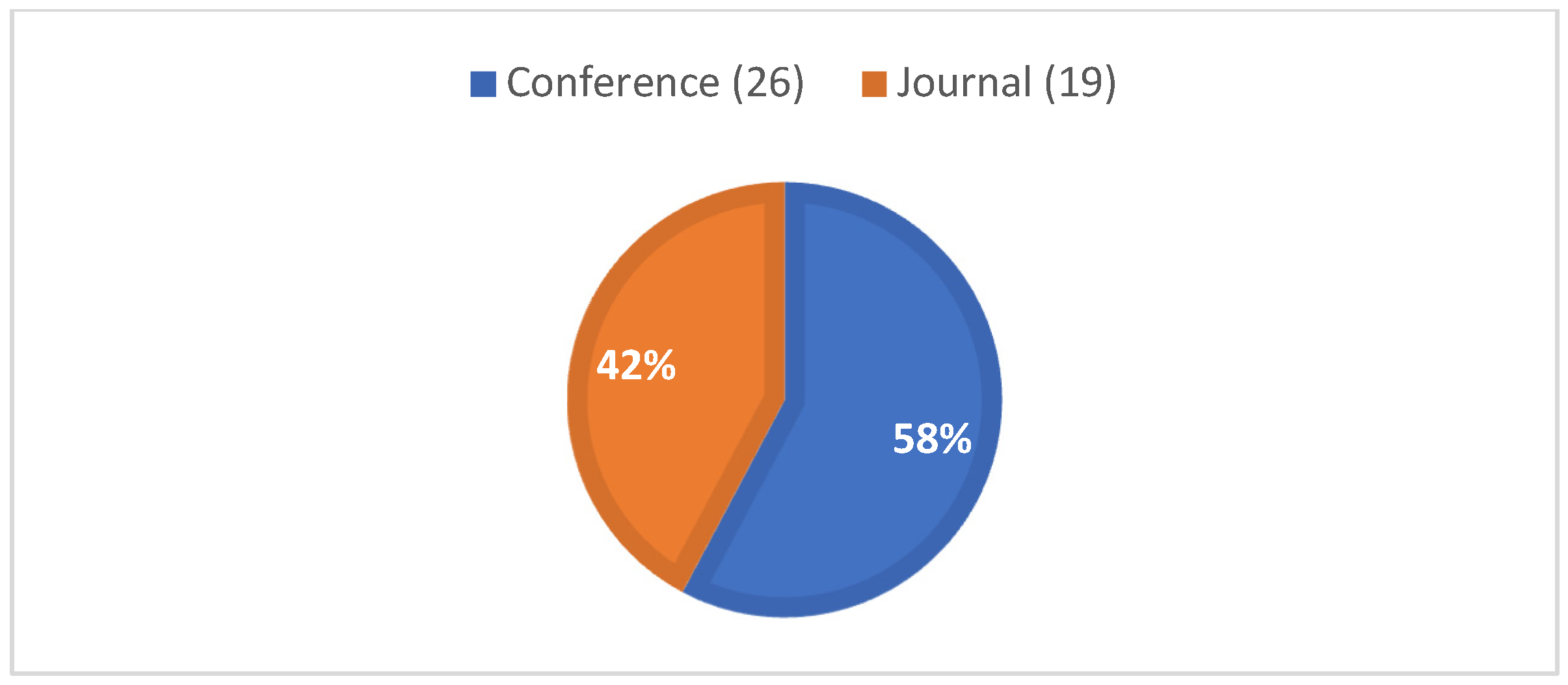
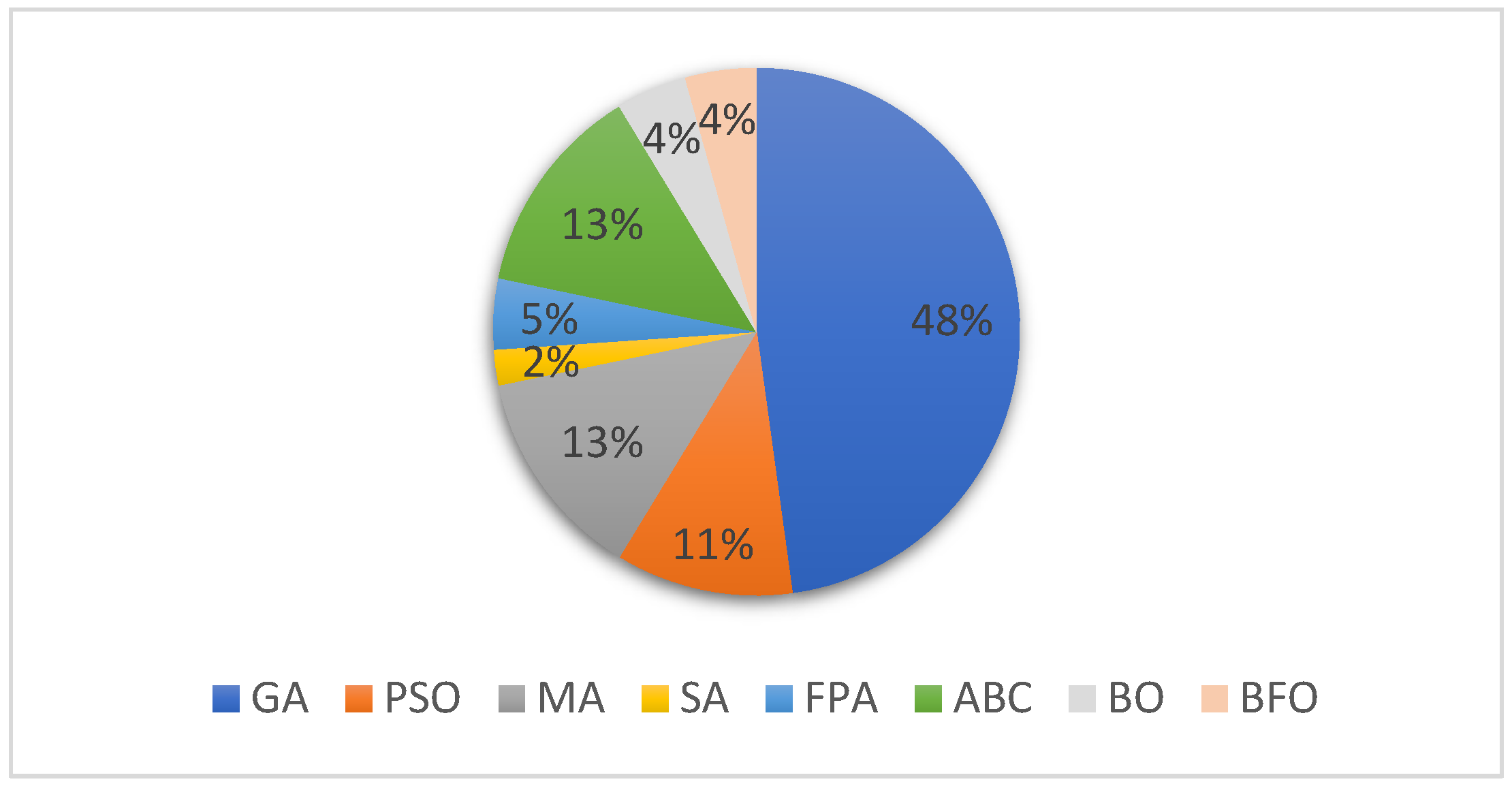
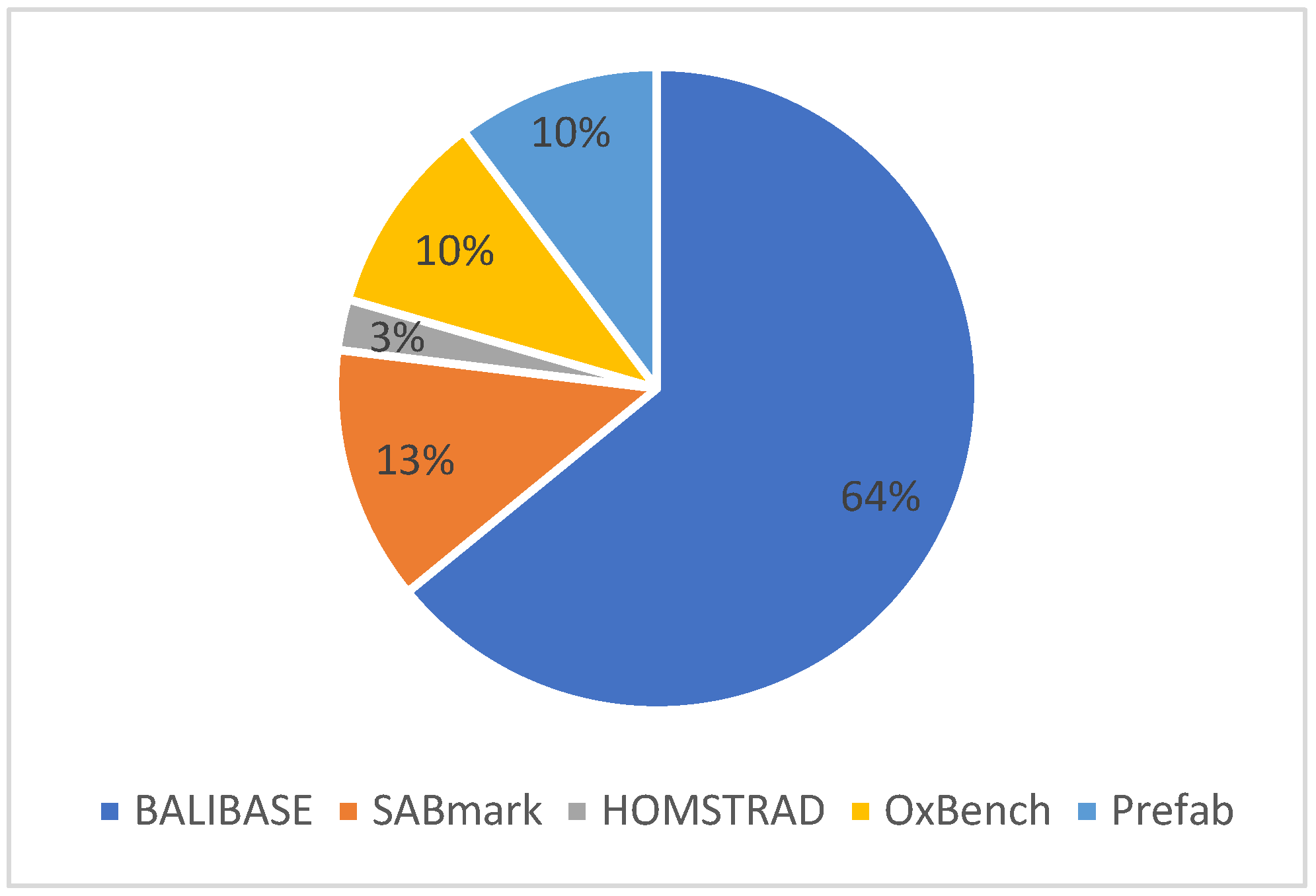
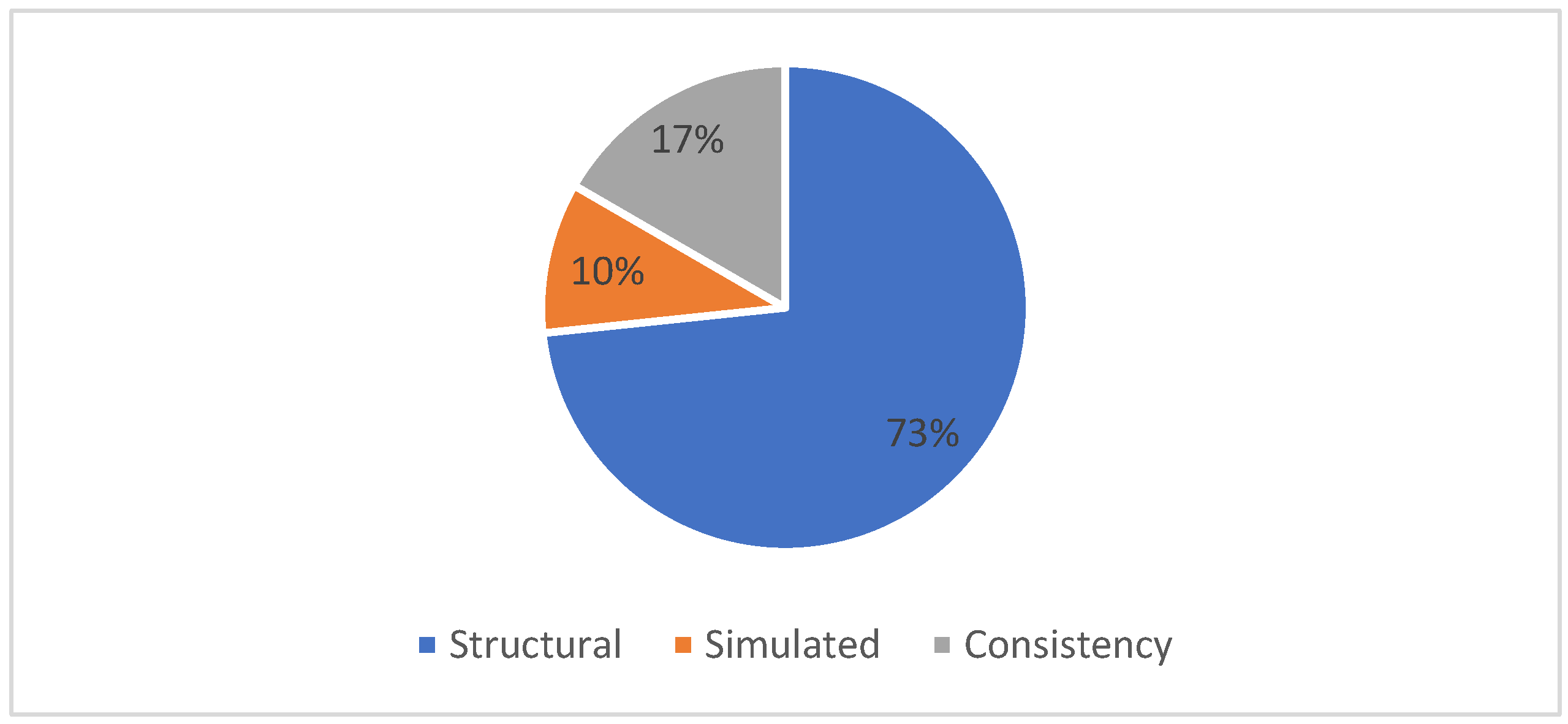
| No. | RQ | Motivation |
|---|---|---|
| 1 | Which bioinspired algorithms (BIA) are commonly employed for MSA? | Identify the popular bioinspired algorithms for MSA. |
| 2 | What benchmark datasets are popularly applied to the evaluation of MSA problems? | To identify the benchmark datasets commonly used to evaluate MSA solutions. |
| 3 | What are the Quality Measure techniques (QM) used for the MSA? | Identify the popular bioinspired-based Quality Measure techniques used for MSA. |
| 4 | What are the current trends, issues, and prospects for further study? | Determine the trends, research issues, and future directions in the bioinspired-based MSA. |
| String | IEE | ACM | SCOPUS | Bioinformatics | SpringerLink | Total |
|---|---|---|---|---|---|---|
| A | 7 | 2 | 16 | 2 | 4 | 31 |
| B | 32 | 5 | 300 | 3 | 6 | 346 |
| C | 12 | 1 | 150 | 3 | 13 | 179 |
| D | 8 | 3 | 200 | 10 | 10 | 224 |
| E | 3 | 2 | 32 | 6 | 6 | 44 |
| F | 7 | 3 | 150 | 4 | 4 | 168 |
| Total | 69 | 16 | 848 | 28 | 31 | 992 |
| Inclusion | Exclusion |
|---|---|
| Studies that solely focus on experimental results. | Research without empirical findings was disregarded. |
| Papers focusing on the use of bioinspired-based methods to solve MSA. | Papers that concentrate on other techniques used for MSA are excluded. |
| Research works released between 2010 and 2024. | Research released before 2010 was not included. |
| Studies that are only written in English. | Research papers published in other languages. |
| Only conferences and journals are considered. | Other sources are not included, including books, theses, and magazines. |
| Search Method | Extracted Information | Purpose |
|---|---|---|
| Manual | The class of bioinspired algorithms that the paper examined. | RQ1 |
| Benchmark methods were used to address the MSA problem. | RQ2 | |
| Future directions and challenges. | RQ3 | |
| Study’s conclusion. | RQ1, RQ2, and RQ3 | |
| Automatic | Title of the study. | Study description |
| Year of publication. | ||
| Names of the authors. | ||
| Publication type (conference proceeding or journal article). |
| Model | Description | References |
|---|---|---|
| GA | An evolutionary algorithm based on natural selection and genetics is utilized to find approximate solutions to optimization and search problems. | [12,21,22,33,47,48,49,50,51,52,53,54,55,56,57,58,59,60,61,62,63,64] |
| PSO | A population-based stochastic method that simulates the movement and cooperation of particles inspired by the social behavior of birds and fish. | [10,20,65,66,67] |
| Memetic Algorithm | A technique that blends local search methods with evolutionary algorithms, such as genetic algorithms. | [13,14,15,16,17,18,19,20,21,22,23,24,25,26,27,28,29,30,31,32,33,34,35,36,37,38,39,40,41,42,43,44,45,46,47,48,49,50,51,65,66,67,68,69,70,71,72,73,74,75,76,77,78,79,80,81,82,83,84,85,86,87,88,89,90] |
| Simulated Annealing | A technique for probabilistic optimization that draws inspiration from the metallurgical annealing process. | [91] |
| The Flower Pollination Algorithm | An algorithm that mimics the natural process of pollination in blooming plants, in which pollen is spread from one flower to another and fertilizes the plants. | [92,93] |
| Artificial Bee Colony | A method for population-based optimization influenced by honeybee foraging. | [14,94,95,96,97] |
| Biogeography-based Optimization | An optimization algorithm inspired by nature that is grounded in biogeography, the study of species distribution across various geographic regions. | [84,98] |
| Bacterial Foraging Optimization | A nature-inspired optimization algorithm that is inspired by the foraging of bacteria. | [74,99] |
| Benchmark | Test Alignment | Sequence Type | No of Subsets | Number of Set Alignments | References |
|---|---|---|---|---|---|
| BAliBASE | Multiple | Protein/RNA/DNA | 6 | 217 | [12,18,21,30,33,37,48,49,50,51,59,60,61,62,63,64,67,72,73,74,75,99,104] |
| SABmark | Pairwise | Protein/DNA | 2 | 634 | [68,74,85,99,104] |
| HOMSTRAD | Multiple | Protein | - | - | [88] |
| OXBench | Multiple | Protein | 3 | 673 | [67,85,99] |
| Prefab | Pairwise | Protein | 3 | 1932 | [68,74,99,104] |
| Technique | Description | Scoring Method | References |
|---|---|---|---|
| Structural | Based on the idea that amino acid residues that correspond to the same position in the three-dimensional structure should be aligned. |
| [22,47,53,54,55,56,57,58,72,74,76,86,87,97,116,117,118,119] |
| Simulated | A probabilistic model simulates sequence evolution and produces evolved sequences and reference alignments. |
| [110,111,112] |
| Consistency | It is predicated on the notion that two residues are probably accurately aligned if many software programs reliably align them. |
| [104,113,120,121,122] |
Disclaimer/Publisher’s Note: The statements, opinions and data contained in all publications are solely those of the individual author(s) and contributor(s) and not of MDPI and/or the editor(s). MDPI and/or the editor(s) disclaim responsibility for any injury to people or property resulting from any ideas, methods, instructions or products referred to in the content. |
© 2024 by the authors. Licensee MDPI, Basel, Switzerland. This article is an open access article distributed under the terms and conditions of the Creative Commons Attribution (CC BY) license (https://creativecommons.org/licenses/by/4.0/).
Share and Cite
Ibrahim, M.K.; Yusof, U.K.; Eisa, T.A.E.; Nasser, M. Bioinspired Algorithms for Multiple Sequence Alignment: A Systematic Review and Roadmap. Appl. Sci. 2024, 14, 2433. https://doi.org/10.3390/app14062433
Ibrahim MK, Yusof UK, Eisa TAE, Nasser M. Bioinspired Algorithms for Multiple Sequence Alignment: A Systematic Review and Roadmap. Applied Sciences. 2024; 14(6):2433. https://doi.org/10.3390/app14062433
Chicago/Turabian StyleIbrahim, Mohammed K., Umi Kalsom Yusof, Taiseer Abdalla Elfadil Eisa, and Maged Nasser. 2024. "Bioinspired Algorithms for Multiple Sequence Alignment: A Systematic Review and Roadmap" Applied Sciences 14, no. 6: 2433. https://doi.org/10.3390/app14062433
APA StyleIbrahim, M. K., Yusof, U. K., Eisa, T. A. E., & Nasser, M. (2024). Bioinspired Algorithms for Multiple Sequence Alignment: A Systematic Review and Roadmap. Applied Sciences, 14(6), 2433. https://doi.org/10.3390/app14062433





